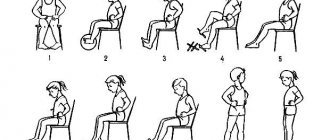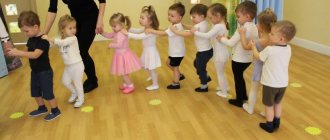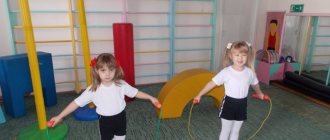Goals of eye gymnastics in a preschool institution
Exercise is an effective means of preventing eye diseases and correcting ailments. Eye gymnastics for children, as well as self-massage, dynamic pauses and breathing exercises, are modern health-saving technologies. But the very first elements of such gymnastics, aimed at maintaining visual acuity, were invented by Indian yogis.
The easiest and most accessible exercise for children is covering their eyes with their hands.
At preschool educational institutions, visual gymnastics is performed for the following purposes:
- General improvement of the visual system, prevention of visual impairment: strengthening the eye muscles, relieving general tension, fatigue, improving blood circulation.
- Treatment of already acquired pathologies: myopia, farsightedness, astigmatism.
- Formation in kindergarten students of the concept of caring for their health, including vision.
- Formation of spatial orientation skills in children (consolidation of such concepts as “right-left”, “up-down”, “turn”.
Important! Visual gymnastics for children affects the development of coherent speech, enrichment of vocabulary, and helps to consolidate familiar ideas about the surrounding reality.
Exercises involving fixation of gaze on a moving object develop the skill of visual-spatial orientation
Gymnastics for the eyes - a health-saving technology in preschool educational institutions
Galina Mandrovskaya
Gymnastics for the eyes - a health-saving technology in preschool educational institutions
“ Health is not everything , but without health everything is nothing ”
Socrates
Currently, one of the most important and global problems is the state of children's health . Raising a healthy child is the most important thing that we, preschool teachers, need to do. Full physical development and health of a child is the basis for personality formation. And the main task of adults is to help children maintain the health of the whole body for many years. Therefore, from a very early age, children need to be taught certain manipulations that will help them maintain the optimal condition of their organs and systems in later life.
The topic of my report was not chosen by chance, because while working with middle-aged children, I noticed that children, when they came from home to kindergarten, when I asked what you did on the weekend, in most cases they answered that they played computer, or watched TV. But it’s no secret that in the age of information technology , children’s bodies are exposed to great influences of factors that negatively affect health . Everyone knows that phones, computers, tablets, and televisions put a strain on children’s visual apparatus every day. Therefore, preventive and corrective work with the visual organs appears today as a necessary component of the educational activities of preschool educational institutions. It is important not only to teach children to perform special exercises in the system, but also to understand the need to take care of their vision and health in general . One of the forms of work on the prevention and correction of visual impairment and visual fatigue is visual gymnastics .
Gymnastics for the eyes is one of the techniques for improving the health of children ; it belongs to modern health-saving technologies , along with breathing exercises , self-massage, and dynamic pauses.
Although, the first exercises for preserving vision were created long before our era. Yogis, creating complexes for the whole body, did not forget about our eyes . They knew for sure that for the best results you need not only training, but also proper rest.
The purpose of eye gymnastics : prevention of visual impairment in preschoolers.
Tasks:
-prevention of fatigue,
-strengthening the eye muscles ,
- stress relief,
- general improvement of the visual system.
Gymnastics for the eyes has a beneficial effect on the performance of the visual analyzer and the entire body.
No special conditions are required to perform eye exercises Any gymnastics for the eyes is done while standing .
Visual gymnastics should be carried out regularly 2-3 times a day for 3-5 minutes.
When carrying out, a visual demonstration of the teacher’s actions is very important.
Based on the name of the eye gymnastics, it is easy to match it to the topic of OD.
There are several types of eye gymnastics .
According to the use of artistic words, gymnastics for the eyes can be divided into those that have poetic accompaniment and those that are performed without it.
Based on the use of additional attributes, 4 types can be distinguished:
1) With objects. For example: working with cards located on the walls. They contain small silhouette images of objects, letters, syllables, numbers, geometric shapes, etc. (the size of the depicted objects is from 1 to 3 cm)
.At the request of the teacher, the children get up and perform a number of tasks: look for pictures on the walls that are the answer to the riddle; find images of objects whose names contain the desired sound, etc.
2) Without attributes (no objects or posters are used)
;
3) Using special fields (any colored shapes are depicted (oval, figure eight, wave, spiral, rhombus, etc.)
or intricately crossed lines of different colors 1 cm thick. This poster is placed above
eye in any convenient place (above the board, on the side wall and even on the ceiling)
.
At the request of the teacher, children begin to “run” their eyes along a given trajectory.
At the same time, it is advisable to give each exercise a playful or creative character. 4) Using ICT. There are specialized programs aimed at relieving tension and correcting vision. As a rule, they are expensive and are little used in preschool educational institutions. But multimedia gymnastics for the eyes is easy to do yourself, using the PowerPoint program to create presentations, where any object can be given a specific movement (Animation tools)
. This is convenient when using direct educational activities based on a presentation, when the teacher selects pictures on a topic and inserts it into the desired stage.
In my activities, I try to use all types of eye gymnastics , alternating them wisely.
Taking into account the characteristics of preschool children, in order to attract their attention to performing these movements, I offer exercises in a poetic, playful form. In this case, they will not only be useful, but also interesting for children.
When planning gymnastics , I take into account the principle of complication, first working out simple eye : right-left, up-down, circular movements, squinting, blinking, protruding eyes , and then moving on to more complex movements using poetic text in various combinations. At first I use small poetic text (up to 4 lines), and then move on to longer ones.
In the first lessons, while reading a poem, I perform eye , the children repeat after me, in subsequent lessons the children independently pronounce the words and perform movements in accordance with the text. The most interesting thing in our group is eye exercises , which use objects or tasks in poetic form, movements along certain paths, tasks to find objects and pictures in different parts of the group.
The following exercises are most popular among the children in my group:
"Palms"
- closing
your eyes for thirty seconds to relieve eye .
"Owl"
- the child is asked to close his eyes tightly, and then quickly open
his eyes as much as possible and fixate them for a few seconds.
"Far close"
- a game during which the child moves
his eyes from an object in the room to an object far away outside the window.
"Leaves"
- follow the falling leaves with your eyes while keeping your head motionless.
"Sun"
- repeat
with your eyes the trajectory of the sun (from left to top and right to bottom)
.
In addition, children really like multimedia eye gymnastics .
I make sure that children do not get tired during visual gymnastics , and after gymnastics I practice relaxation exercises. For example: “Now relax your eyes , blink often, often, lightly, lightly, approximately the way a butterfly flaps its wings.” At the end of the exercises, be sure to close your eyes for a few seconds and then blink 10 times.
In addition to preventive benefits, visual gymnastics also has educational value. Performing visual exercises with motor games teaches preschoolers spatial orientation. The simplest concepts are reinforced: “left”
,
"right"
,
"turn"
,
"turn"
.
In addition, visual gymnastics contributes to the enrichment of vocabulary, the development of grammatical components of the language and coherent speech.
The eyes are the most valuable sense organ, as we receive approximately ninety percent of information through them. Good vision is needed for all areas of activity - everyday life, recreation and study. But every modern child faces enormous strain on the eyes , while the visual apparatus can only rest during sleep. A significant number of vision problems develop in early childhood, so preventing their occurrence is extremely important.
According to experts, eye gymnastics helps everyone, without exception, improve their vision and maintain it at the proper level.
The advantage of eye gymnastics is that the time spent on exercises is measured in minutes, and the benefits of this type of activity for the child’s health are invaluable .
Types of visual gymnastics in preschool educational institutions
In children's institutions, several sets of eye exercises are used:
- Without visualization (children perform actions according to the verbal instructions of the teacher) and the participation of attributes (pupils visually track the movements of a toy or object).
- Preventive, corrective (slows down the development of astigmatism, myopia, farsightedness, etc.).
- Passive (gymnastics affects only the oculomotor effect) and active (combined with general strengthening exercises for the arms, legs, and back).
Note! Among the preventive complexes, the most effective is considered to be eye exercises according to Avetisov for children. In total, the author created 3 complexes , each of which helps to improve certain visual processes.
Complex No. 2 is aimed at strengthening the eye muscles:
- Children, without moving their heads, draw a line to the floor 15 times with their eyes.
- Pupils first draw a trajectory with their eyes “to the side - up”, and then “to the side - down”. Repeat 20 times.
- Look in the direction “left-up”, “right-down”. Perform 15 times.
- Circular movements of the eyes: first clockwise, then counterclockwise. Do 12 times.
Complex No. 1 normalizes blood circulation, and complex No. 3 normalizes accommodation.
Children perform active exercises with great interest
Exercises
Eye gymnastics for schoolchildren should be performed at least 2-3 times a day. Systematic exercises will help the student relieve tension and fatigue from the organ of vision, improve blood circulation and strengthen muscles. For the most part, they are aimed at preventing eye diseases, but can be used in treatment, in the absence of contraindications. The duration of classes should not exceed 10 minutes. At the initial stage, it is recommended to start with simple exercises, gradually increasing the load and introducing new ones.
All gymnastics are performed in a comfortable sitting position. If the child is of primary school age, they can be combined with outdoor games, then the procedure will not be tiring for him, and he will be involved in the gameplay with interest. Children attending educational institutions are recommended to perform the complex at school, during any of the breaks. You should start training by performing each exercise 2-3 times, gradually increasing the number of repetitions to 6-8.
- Blind Man's Bluff. The child closes his eyes with effort for 3-4 seconds. Then he opens them for the same time. It has a relaxing effect while strengthening muscles.
- Blinking. Without tension, the child blinks quickly, easily, without straining the muscles of the eyelids. Duration up to 1 minute. Blood circulation and blood supply improves.
- Traffic light. In turn, you need to close your right or left eye, imitating the blinking of a traffic light. In addition to the obvious benefits for the eyes, we develop coordination and orientation.
- Pendulum. The gaze slowly moves from left to right and back, depicting the ticking of a pendulum. In this case, the head should not change its position.
- Floor ceiling. Without turning your head, we look down and up. Subsequently, it can be complicated by combining it with the fourth.
- Peepers. The exercise is performed in pairs. Two sit opposite each other and look intently into the eyes; whoever blinks first closes his eyes and pretends to be sleeping. After rest we repeat.
- Watch. Slowly, without turning your head, make a circle with your eyes, first clockwise and then counterclockwise.
- Crosses. We draw an impromptu cross for the eyes, moving our gaze: up and to the right, then left and down, and in the reverse order.
- Far close. The exercise can be done in a room, on the street or near a window. The most distant object is selected and the child is asked to carefully examine it for 10-15 seconds, and then move his gaze to a very close object: a finger, a toy, a table, located at a distance of 30 cm from the eyes.
- Eyelid massage. Gently, without pressing with your fingers, massage the upper eyelid from the inner to the outer edge, and the lower eyelid, vice versa. Execution time is no more than 1 minute.
To achieve results and make such gymnastics a habit, classes must be regular and completed on time. Unfortunately, not only children, but also parents can forget about a fun eye game, then as a reminder, you can use the organizer of a mobile phone or other device, as well as a regular alarm clock.
Currently, a significant number of techniques have been developed for the treatment of eye diseases that can correct the situation in the shortest possible time, but many of them are associated with risks and give short-term results. Therapeutic gymnastics for the eyes is a traditional method of treatment and prevention and is recommended for use in complex therapy. Like any procedure, eye exercises should be done after consultation with a doctor. Some exercises have contraindications. Gymnastic techniques are not used for retinal detachment and during the recovery period after eye surgery.
The eyes are most relaxed when looking into the distance. You need to be in nature more often, take a break from gadgets and the computer - this is the best gymnastics for the eyes.
Methods of visual gymnastics
Eye exercises are suitable for children as early as preschool age. They are performed with children not 1, but 2-3 times a day. In junior and middle groups, 3 minutes are allotted for this, and in senior groups, the duration of classes can already take 4-5 minutes.
When performing exercises you need to follow the rules:
- Pupils should be in a relaxed state.
- The head position is fixed (if gymnastics is not performed in combination with exercises that involve neck movements).
- Before starting gymnastics, you should remove your glasses (if children wear them).
- Breathing during exercise is deep and even.
To arouse the interest of students in gymnastics, it is carried out in a playful way. For example, when closing your eyes, you can offer to depict an owl or a cat. Children also enjoy performing activities to fun rhymes and music.
Games for developing memory and attention in children
Attention! There is no specific time for charging. It is organically combined with a walk and any planned activity (productive activity, speech development). For example, when studying insects, in the junior and middle groups you can “trace the flight of a dragonfly.”
If the lesson involves a load on the eyesight, then it is more rational to do gymnastics in the middle of the lesson to relieve some of the tension. If there is no load, then the exercises are transferred to the second half of the lesson to relieve fatigue from the lesson itself.
It is better to complete the complex by blinking, then the kids should stretch.
Features of working with preschoolers of different ages
To interest a child in performing visual gymnastics, you need to take into account his age.
Note! So, when teaching a 2-3 year old child, you should not hope that he will be carried away by the “rotate your eyes” command. In this case, it is worth using a pedagogical trick. Kids will be happy to follow the flight of a bird attached to a pointer or a simple pencil, or the movements of a finger puppet.
Children 3-4 years old are ready to repeat a lot after the teacher and his stimulating phrase: “This is what I can do. And you?" - will definitely attract their attention.
It is better to combine visual gymnastics with students with some kind of hand movements
Note! Older children 5-6 years old show curiosity and can be motivated by a story about the structure of a person, for example, how the eye works, which allows everyone to see the world around them.
Eye exercise for children aged 2-4 years
At this age, a child, as a rule, is not yet able to concentrate on one activity for a long time. It means that:
- The duration of the gymnastics should not be long - it is better to perform the exercises about 3 times a day for 1-2 minutes;
- classes should be carried out in a playful way, and this should be done when the baby is in a good mood, he is comfortable, and he is not capricious.
The first exercise, which is called “Blind Man’s Bluff”
, helps strengthen the eye muscles:
- ask the child to close his eyes;
- count to three;
- now tell your baby to open his eyes.
In this case, it is important that the small child learns to first strain his eyes and then relax them. At first, you can invite him to watch you and first close his eyes, sit for a while with his eyes closed, and then open them, so that it is easier for the baby to understand what you want from him.
Second exercise – “Butterfly Wings”
. It aims to improve blood circulation in the eyes.
Let the child imagine that his eyelashes are the wings of a butterfly. For a butterfly to fly, it must flap its wings very quickly, that is, the child must blink intensely. Let one “flight” continue for 10 seconds, then allow your eyes to rest for 5-10 seconds and repeat the exercise one or two more times.
And the third exercise that is suitable for children of this age is “Rhyme Rhymes”
. It makes it possible to relieve tension from the eyes and strengthen the eye muscles.
You recite poems, and the child must make eye movements that correspond to what you say. When performing this exercise, you also need to first show everything by your own example, so that the baby understands what he needs to do.
You can take, for example, these verses:
Here is a big Christmas tree -
That's how tall
(the baby looks up, as if trying to see the top of the tree)
She has big branches -
This is the width
(the baby looks from left to right, as if assessing the width of an imaginary Christmas tree)
There are even cones on the tree
(baby looks up, looking for imaginary bumps),
And below is the bear’s den
(baby looks down)
The clubfoot sleeps there during the winter
(the child closes his eyes, imitating a sleeping bear, then blinks several times and closes his eyes again)
And sucks his paw in the den.
When performing this exercise, you need to make sure that the child moves his eyes and not his head. If necessary, gently correct him and explain again what needs to be done.
Card file of gymnastics for the eyes with goals according to the Federal State Educational Standard
Eye exercises have many complexes, but all of them can be grouped for preschoolers by age.
First and second junior groups
The card index for kids is especially rich.
Note! Thematic ophthalmological exercises for group 1 are aimed at preserving and improving vision, preventing farsightedness and myopia.
- "Pilot"
An airplane flies by. (Children look up.)
I'm going on a flight with him.
I move my wing to the right and look. (The guys move their right hand, look to the right).
I move my wing to the left and look. (Kids move their left hand, look to the left).
I'm starting the engine
And I'm watching closely. (Follow the rotational movements of the hands with their eyes.)
I rise up, I fly. (They stand on their tiptoes and draw waves with their eyes.)
I don't want to go back. (Blink, close your eyes).
- "By the berries"
On the right are sweet blueberries. (Children look to the right).
Strawberries are ripening on the left. (The guys look to the left).
Lingonberries are singing on the mountain. (Kids look up).
There are blackberries underfoot. (The students look down.)
We'll pick the berries
And then we’ll all rest and go home in a crowd. (Close eyelids for 3-5 seconds, repeat up to 8 times).
In order to maintain visual acuity in the 2nd junior group, eye exercises are performed:
- "Autumn"
Autumn colors were bright,
I quietly ran my brush over the leaves. (Children draw a circle with their eyes: left - up - right - down).
The hazel trees turned yellow, the maples turned red. (Circular movements: right-up-left-down).
Only in the forest the pines were also green. (Kids close their eyes, blink 10 times. Repeat 2 times).
- "Rain"
Rain, rain, more. (Children look up).
Leisure in the thicker puddles. (The guys look down.)
Just don't get us wet. (Pupils make circular movements with their eyes.)
Drops knock on the window.
Important! In younger groups, eye gymnastics should be carried out 2-3 times a week, using small objects to facilitate understanding of the commands of the teacher of the educational institution.
Middle group
The method of conducting gymnastic exercises for preschoolers 3 years old is almost no different from the previous one. Gymnastic exercises for them are carried out in order to prevent visual impairment, prevent fatigue, strengthen the eye muscles and relieve tension during exercise.
- "Wind"
Joint creativity of parents and children: ideas for educational crafts
The wind blows in everyone's face. (Children blink frequently.)
The tree swayed. (The guys look left, then right).
The wind will become quieter. (Pupils squat, look down).
The trees are getting taller. (Stand up, look up).
- "Snout"
The nose looks left and right. (Children move their gaze from right to left.)
The nose looks up and down. (The guys look up and down.)
What did the sly little nose notice? (Run your fingertips over your eyelids).
We got somewhere.
Note! The time for performing visual gymnastics in the middle group increases to 5 minutes.
Senior and preparatory groups
In addition to the health-prophylactic purpose, when doing eye exercises with children 5-6 years old, you can work on the concepts of the spatio-temporal structure of the world.
- "Eye exercise"
Eye exercises
We repeat every time.
Right, left, up and down,
Repeat and don't be lazy.
We strengthen the eye muscles.
We relieve the tension.
A visual aid contributes to a more productive exercise.
- «Watch"
I've been hearing "tick-tock" all year long.
All the clocks go like this
One - left, two - right. (Children's eyes move left and right).
And we can do this too
Tick tock, tick tock. (Repeat the exercise).
Note! At the end, 6-7 year old pupils themselves massage their eyelids with the pads of their index fingers.
More about exercises
Let us tell you in more detail about exercises that help primary schoolchildren preserve their vision. Here, by the way, it is necessary to take into account an important condition. Such exercises will not be performed by the child independently, but in the presence and with the participation of someone older, or at least older.
- “We blink!” The adult counts to five, and the child blinks as vigorously as possible at each count. The exercise is repeated five times with a short break after each execution.
- "We look up and down." We give the command to the baby to look up, then to look down. At the same time, the head should remain motionless, only the eyes “work”. There should be at least four glances “up and down”, then a short rest, after which the exercise is repeated.
- “We look left and right.” The child should slowly move his eyes to the left and then to the right. After this, the baby rests with his eyes closed for a few seconds. Then the exercise is repeated. You need to do 4 repetitions in total.
- “Close and open your eyes.” The child closes his eyes tightly, and on the count of 5, opens them as wide as possible. Then, with wide open eyes, the baby needs to look into the distance. After a short rest, the exercise is repeated 4 times.
- "Making geometry." The child traces with his eyes some geometric figure named by an adult: a circle, a square, etc. It is necessary to “draw with his eyes” four such figures.
- “Let’s make a watch.” We ask the child to turn his eyes clockwise (the head should remain motionless). Next, we rotate our eyes in the opposite direction. We repeat each rotation three times.
- "Let's hide!" The child closes his eyes with his palms, the adult counts to 15, after which the child removes his palms and opens his eyes. The exercise is repeated 4-5 times.
- “Making big eyes.” The child opens his eyes wide, then blinks until the count is 15. After a 10-second rest, the exercise is repeated two more times.
- "Drawing eights." We explain to the child how to draw a figure eight with his eyes - horizontally and then vertically. While performing the exercises, the child must keep his head still. In total, you need to draw five vertical and horizontal eights with your gaze.
- “We do hocus-pocus.” We invite the child to look carefully at some object located in the distance. Let the baby look at it for about 15 seconds. After this, the child should slowly focus his gaze on an object located nearby, and also look at it for that amount of time. After each “wandering of the eyes,” the baby should rest for at least 10 seconds. The exercise is repeated 5 times.
These are such simple, and at the same time extremely useful exercises for the eyes. In addition, one should not forget that, along with exercise, the child eats well, walks in the fresh air, watches less TV and reads more.







